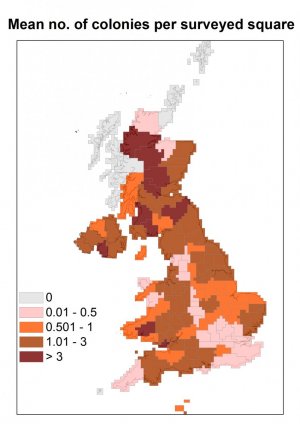House Martin Survey 2015 Results
In this survey a colony is defined as one or more nests on a separate structure.
The main aim of the 2015 survey was to produce a population estimate for House Martins. This would provide a more robust estimate of numbers of this difficult to count species and a baseline against which to measure future changes in numbers. Importantly, it is derived from comprehensive local survey effort and hence can also provide more accurate estimates of population size at the country or county level where survey effort was sufficient.
Provisional Population Estimates
Based on analyses to date, the provisional estimate of House Martins breeding in the UK is 750,000 pairs (range 650,000 to 850,000), with roughly 500,000 estimated to be in England, 150,000 in Scotland, 70,000 in Wales and 30,000 in Northern Ireland. This estimate was based on the number of active nests recorded during survey visits and assumed that an active nest represented a breeding pair. Because we used a stratified random survey design, the country and UK totals could be estimated by extrapolation, accounting for geographical differences in survey effort and the areas of suitable and unsuitable House Martin habitat in regions.
House Martins are a notoriously difficult species to monitor. Previous attempts to estimate UK House Martin populations gave estimates of 273,000-535,000 pairs in 2000 (Baker et al. 2006), based on a ‘number of squares’ method (i.e. multiplying the number of occupied 10-km squares by an informed guess of the number of pairs per occupied square, Gibbons et al. 1993), which was revised to 510,000 pairs in 2009 (Musgrove et al. 2013) using estimates derived from Breeding Bird Survey (BBS) distance sampling (Newson et al.2008). However, both of these approaches were likely to be under-estimates, the first because even a slight under-estimate in the number of pairs per 10-km square would result in large under-estimates of the UK total after extrapolation, and the second in part related to the difficulty with taking into account birds seen in flight in survey analyses. It is therefore important to note that the current population estimate does not reflect an increase in the UK House Martin population size, but rather that the 2015 House Martin survey is based on new data and was designed to better account for these difficulties in monitoring the species.
Ongoing Analyses
We are also currently investigating the relationship between the number of nests and the number of colonies. While House Martins are generally more numerous in the south than in the north, the mean number colonies per surveyed square was higher in the north and west of the UK, in particular in Scotland, and lower in the south and east (Fig. 1 below). This is highlighted by the observation that whereas the survey square with the most colonies was in the Scottish borders (62 colonies), the square with most nests was in a square in Hampshire (130 nests) which were in 6 colonies.
More detailed analyses of this geographical variation in colony size, number of colonies and the relationships with other environmental factors have been undertaken. These analyses are currently being written up as a scientific paper, alongside the population estimate, and other findings will be reported when the paper has been accepted and published.
Additionally, some of the information collected as part of the 2015 survey will subsequently be analysed alongside data from the 2016 and 2017 Nest Study, where the two surveys provide complementary information.
References
Baker, H., Stroud, D.A., Aebischer, J.N., Cranswick, P.A., Gregory, R.D., McSorley, C.A., Noble, D.G. & Rehfisch, M.M. (2006) Population estimates of birds in Great Britain and the United Kingdom. British Birds, 99, 25–44.
Gibbons, D.W., Reid, J.B. & Chapman, R.A. (1993) The New Atlas of Breeding Birds in Britain and Ireland: 1988-1991. T. & A.D. Poyser, London.
Musgrove, A., Aebischer, N., Eaton, M., Hearn, R., Newson, S., Noble, D., Parsons, M., Risely, K. & Stroud, D. (2013) Population estimates of birds in Great Britain and the United Kingdom. British Birds, 106, 64–100.
Newson, S.E., Evans, K.L., Noble, D.G., Greenwood, J.J.D. & Gaston, K.J. (2008) Use of distance sampling to improve estimates of national population sizes for common and widespread breeding birds in the UK. Journal of Applied Ecology, 45, 1330–1338.







Share this page